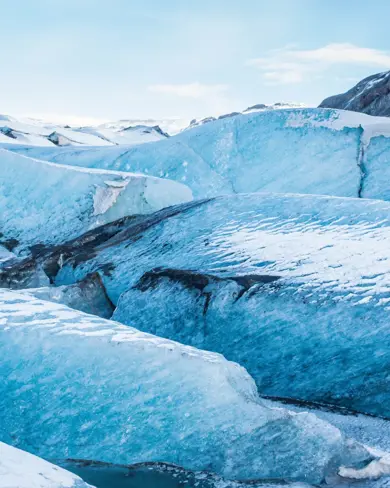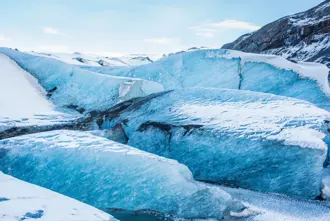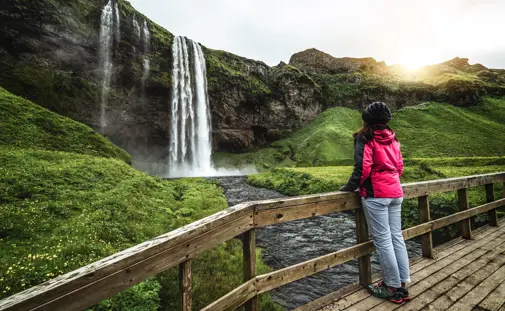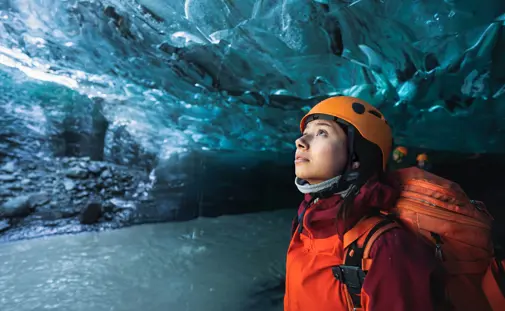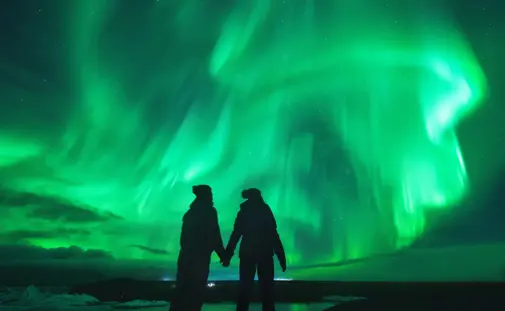Located within the Vatnajökull National Park in Southeast Iceland, Öræfajökull Glacier is one of Iceland’s most extraordinary natural wonders. This glacier has Iceland’s highest peak, Hvannadalshnúkur, and also sits atop an active volcanic caldera, making it a place where the powers of ice and fire coexist in a beautiful landscape. With its deep crevasses, looming icefalls, and dramatic history of volcanic eruptions, Öræfajökull is a must-see for adventurers traveling Iceland.
Öræfajökull Glacier Facts
-
Location: Southeast Iceland, within Vatnajökull National Park
-
Area: Part of the larger Vatnajökull Glacier, Europe’s largest ice cap
-
Elevation: Iceland’s highest peak, Hvannadalshnúkur, reaches 2,110 meters (6,923 feet)
-
Status: Active stratovolcano covered by ice; Iceland’s largest active volcano by volume
-
Last Eruption: 1727-1728, with significant eruptions also in 1362
-
Temperature: Sub-zero at higher altitudes year-round; varies seasonally in lower areas
History & Geology of Öræfajökull Glacier
Öræfajökull has a fascinating geological and cultural history, steeped in both natural forces and Icelandic lore. The glacier sits atop an active stratovolcano that last erupted in 1727-1728, while a particularly catastrophic eruption occurred in 1362. This eruption was one of Iceland’s most destructive volcanic events, resulting in a massive flood of glacial meltwater and ash that devastated local settlements and rendered the area uninhabitable for decades. After the eruption, the once-inhabited area around Öræfajökull was renamed "Öræfi," meaning “wasteland” in Icelandic, due to the barren landscape left in its wake.
The glacier itself is part of the much larger Vatnajökull ice cap, Europe’s largest by volume, and feeds into numerous outlet glaciers and rivers that are vital to the surrounding environment. Öræfajökull’s volcano is constantly monitored for seismic activity due to its active status, although the glacier itself keeps it mostly hidden from view, creating a mysterious and captivating landscape. The entire area, including Hvannadalshnúkur, Iceland’s highest peak, was designated part of Vatnajökull National Park in 2008 to help preserve its unique natural beauty.
Hiking and Activities on Öræfajökull
Öræfajökull Glacier is a popular destination for thrill-seekers and nature lovers. Its deep crevasses, snow-covered landscapes, and expansive views make it a perfect spot for glacier hiking, ice climbing, and mountaineering.
Hvannadalshnúkur Summit Trek
For experienced hikers and mountaineers, reaching the peak of Hvannadalshnúkur is a challenging but rewarding adventure. The trek usually takes around 10-15 hours, depending on conditions, and requires both physical fitness and experienced guides, as the route traverses snowfields, steep inclines, and crevassed areas. The ascent provides unparalleled views of the vast Vatnajökull Glacier and, on clear days, breathtaking vistas of the Atlantic coastline.
Guided Glacier Tours
If summiting Hvannadalshnúkur is too ambitious, numerous guided glacier hikes take visitors onto Öræfajökull’s icy surface. These tours, ranging from short introductory walks to full-day adventures, allow visitors to experience the glacier’s unique formations up close, including ice caves, blue ice, and crevasses. Guides provide necessary equipment like crampons and ice axes, making it accessible even to those without previous glacier experience.
Photography and Sightseeing
Öræfajökull’s dramatic landscapes make it a paradise for photographers. The contrast between the icy glacier and the dark volcanic rock below creates striking scenes, while the nearby Skeidararsandur black sand plains provide a stunning backdrop for capturing the glacier in all its glory. The area is also rich in wildlife, with arctic foxes and a variety of bird species making appearances in the surrounding valleys.
Nearby Attractions
The area surrounding Öræfajökull is packed with natural wonders, each with its own unique appeal. Visitors often combine a glacier hike with visits to some of Iceland’s most iconic locations.
Skaftafell Nature Reserve
Skaftafell, part of Vatnajökull National Park, is located close to Öræfajökull and offers a range of hiking trails suitable for all levels. One of the most popular hikes leads to Svartifoss, a beautiful waterfall framed by hexagonal basalt columns. Skaftafell also offers short trails with views of Öræfajökull, making it a great base for exploring the glacier from a distance.
Jökulsárlón Glacier Lagoon
Less than an hour’s drive from Öræfajökull, the Jökulsárlón Glacier Lagoon is one of Iceland’s most photographed attractions. Here, large icebergs break off from the Breiðamerkurjökull Glacier and float serenely in the lagoon before being carried out to the nearby Diamond Beach. The lagoon is a fantastic spot for witnessing the life cycle of a glacier, from ice formation to eventual melting.
Fjallsárlón Lagoon
Another stunning glacier lagoon, Fjallsárlón offers a more secluded alternative to Jökulsárlón. This tranquil spot, fed by the Fjallsjökull glacier tongue, allows visitors to get up close to the floating icebergs without the larger crowds. Kayaking tours are available in summer, providing a unique and immersive way to experience the lagoon’s beauty.
Ingólfshöfði Cape
For those interested in Iceland’s wildlife, Ingólfshöfði Cape is a great destination near Öræfajökull. This isolated headland is a breeding ground for puffins, skuas, and other seabirds during the summer months, making it a popular spot for bird-watching and photography. Visitors can take a guided tour to the cape, which involves a tractor ride across the black sands, adding to the adventure.
Öræfajökull Location
Öræfajökull is located in Southeast Iceland, within Vatnajökull National Park, near the Ring Road (Route 1) that circles Iceland. It’s situated between the towns of Höfn to the east and Kirkjubæjarklaustur to the west, both of which are popular stops on Iceland’s South Coast.
GPS Coordinates: Hvannadalshnúkur, Öræfajökull’s highest point: 64°00'45.6"N, 16°41'46.4"W
How to Get to Öræfajökull Glacier
Öræfajökull is accessible from Iceland’s Ring Road, making it relatively easy to reach by car. From Reykjavik, the drive takes around 4-5 hours, covering approximately 320 kilometers along the scenic South Coast. Once near the glacier, guided tours for hikes and climbs can be arranged in the nearby Skaftafell Visitor Center, where most glacier tours depart.
For travelers relying on public transportation, several bus routes service the South Coast during the summer months, with stops at Skaftafell. Tour operators in Reykjavik also offer day trips and multi-day tours to Öræfajökull, often combined with other South Coast attractions like Jökulsárlón and the black sand beaches of Vík.
Parking and Facilities
Parking for Öræfajökull is available at the Skaftafell Visitor Center, which serves as the main access point for tours and trails leading up to the glacier. Skaftafell also provides essential amenities, including restrooms, a small café, and informational displays. Those setting out on glacier hikes or the Hvannadalshnúkur summit are advised to start from this location, as it offers both parking and proximity to the main trails.
Öræfajökull in Winter: Can You See the Northern Lights?
Wintertime at Öræfajökull transforms the landscape into a frozen wonderland. Although the hiking trails are more challenging due to ice and snow, winter visitors can enjoy the serene beauty of the glacier in its quietest season. Additionally, the area surrounding Öræfajökull offers an ideal location for witnessing the Northern Lights due to its remote location and lack of light pollution. The long winter nights from September to March increase the likelihood of spotting the aurora borealis, which can often be seen dancing above the glacier, casting a green and purple glow over the icy landscape.
